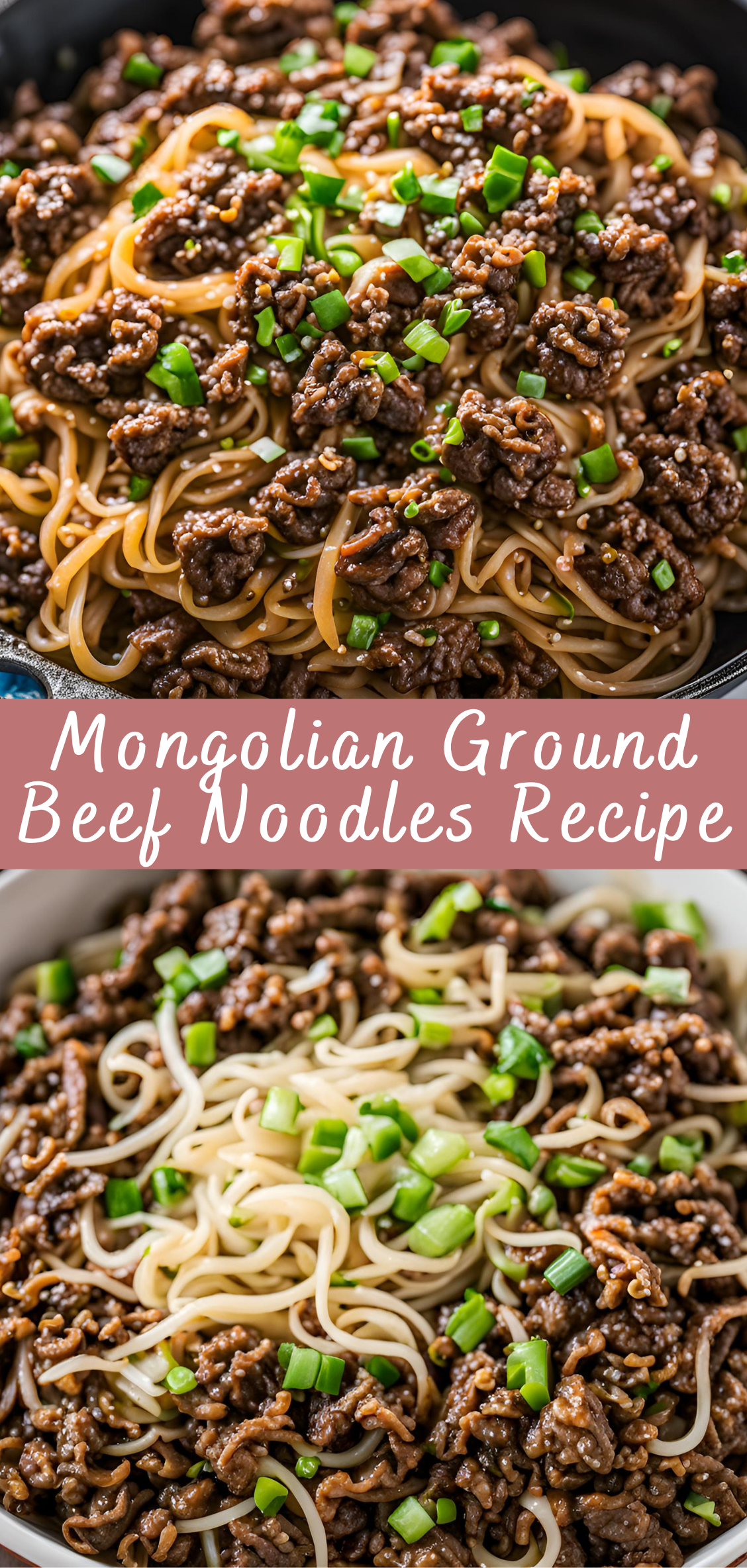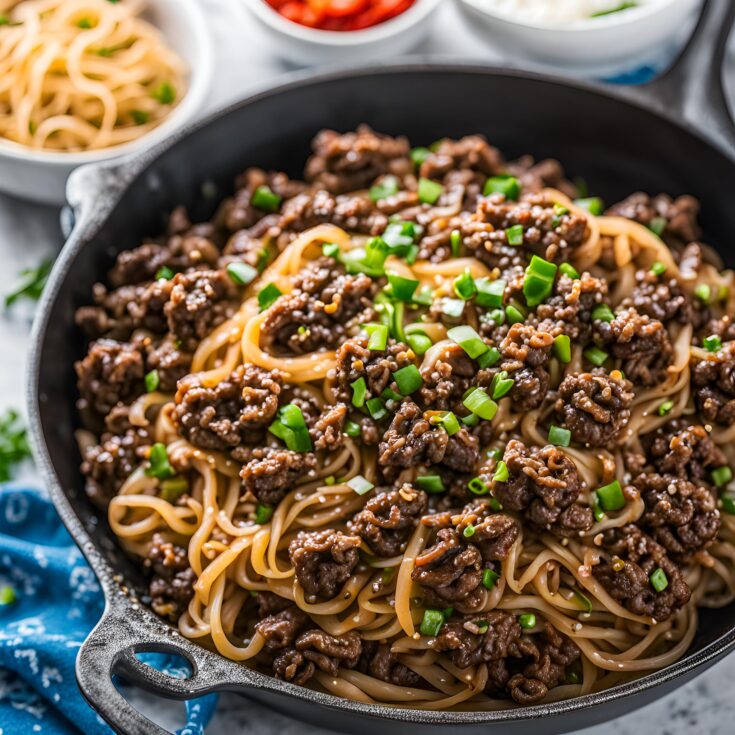Mongolian Ground Beef Noodles Recipe
Here’s a detailed and flavorful Mongolian Ground Beef Noodles Recipe that combines the rich taste of Mongolian beef with the heartiness of noodles. This recipe not only offers a fantastic meal but also goes deep into the origins, ingredient choices, and cooking techniques to ensure you create a perfect dish every time.

Introduction
Mongolian beef, a dish often found in American-Chinese restaurants, is traditionally made with slices of beef in a savory, slightly sweet soy-based sauce. This recipe puts a twist on the classic by using ground beef and pairing it with noodles to create a satisfying, budget-friendly meal that’s perfect for a weeknight dinner. The dish combines savory umami flavors, with a touch of sweetness, and chewy noodles to make a well-balanced meal that’s ready in less than 30 minutes.
History of Mongolian Beef
Despite the name, Mongolian beef has little to do with Mongolian cuisine. It is actually a Chinese-American creation, originally inspired by Mongolian BBQ, where thin slices of meat are stir-fried on an open grill. Over time, the dish evolved into the familiar Mongolian beef seen in restaurants today, characterized by its rich soy-based sauce, garlic, ginger, and a hint of sweetness. The version using ground beef and noodles is a modern adaptation, making the dish easier and faster to prepare.
Equipment Needed
- Large skillet: For cooking the ground beef and vegetables.
- Medium saucepan: To cook the noodles.
- Whisk: For combining the sauce ingredients.
- Wooden spoon or spatula: For stirring while cooking.
- Colander: To drain the noodles.
- Grater: To mince the ginger and garlic.
Instructions
Step 1: Prepare the Noodles
- Cook the noodles: Bring a pot of salted water to a boil. Add the noodles and cook according to the package instructions until they are al dente. Usually, this takes about 6-8 minutes, depending on the type of noodles. You want them slightly firm, as they will continue to cook later when combined with the beef mixture.
- Drain and set aside: Once cooked, drain the noodles and rinse them with cold water to stop the cooking process. Set aside and toss lightly with a drizzle of sesame oil to prevent sticking.
Step 2: Cook the Ground Beef
- Heat the skillet: In a large skillet over medium-high heat, add 1 tablespoon of vegetable oil.
- Brown the beef: Once the oil is hot, add the ground beef to the skillet. Break it up with a spoon or spatula as it cooks. Cook for about 5-7 minutes, until the beef is browned and cooked through.
- Drain the excess fat: If necessary, drain any excess fat from the beef, especially if using ground beef with higher fat content. Lean ground beef typically produces less grease, but you may still need to drain off some excess.
Step 3: Cook the Aromatics and Vegetables
- Add the onions: To the browned beef, add the diced onions. Sauté for about 2-3 minutes, until the onions are soft and translucent. The onions will add sweetness and texture to the dish.
- Add garlic and ginger: Stir in the minced garlic and grated ginger. Cook for another minute until fragrant. These two ingredients are key to building the classic Mongolian flavor profile.
- Cook the vegetables: Add the julienned carrots, bell peppers, and the white parts of the green onions. Sauté for 3-4 minutes, until the vegetables are tender but still crisp. This will add color, crunch, and additional nutrients to the dish.
Step 4: Prepare the Sauce
- Mix the sauce ingredients: In a small bowl, whisk together the soy sauce, hoisin sauce, oyster sauce, brown sugar, and beef broth. This mixture creates the savory-sweet base of the dish.
- Add the cornstarch slurry: In a separate small bowl, mix 1 tablespoon of cornstarch with 1 tablespoon of water to create a slurry. This will help thicken the sauce and make it cling to the beef and noodles.
- Pour in the sauce: Add the sauce mixture to the skillet with the beef and vegetables. Stir well to combine and let the sauce come to a simmer. Once simmering, stir in the cornstarch slurry and cook for 2-3 minutes until the sauce thickens.
- Add sesame oil: For a rich, nutty flavor, stir in 1 tablespoon of sesame oil at the end of cooking.
Step 5: Combine with Noodles
- Add the noodles to the skillet: Once the sauce has thickened, add the cooked noodles to the skillet with the beef and vegetables. Toss everything together, ensuring the noodles are well-coated with the sauce.
- Simmer briefly: Let the mixture cook for 1-2 minutes, just to allow the flavors to meld and the noodles to absorb some of the sauce.
Step 6: Garnish and Serve
- Garnish: Remove the skillet from the heat and sprinkle with sesame seeds and the green parts of the chopped green onions for added flavor and presentation.
- Serve: Serve the Mongolian Ground Beef Noodles immediately while hot. This dish pairs well with steamed broccoli or a simple cucumber salad.
Cooking Tips and Tricks
- Choosing the Right Beef: Opt for lean ground beef (90% lean/10% fat) to keep the dish lighter and avoid excess grease. If using higher-fat beef, be sure to drain the fat after cooking.
- Vegetable Options: You can easily customize the vegetables in this dish based on what you have on hand. Broccoli, snap peas, or zucchini are great options to add more greens and crunch to the meal.
- Noodles: Traditional lo mein or ramen noodles work best, but in a pinch, spaghetti or linguine can be substituted. Make sure not to overcook the noodles so they don’t become mushy when combined with the sauce.
- Thickening the Sauce: Cornstarch is key to giving the sauce its glossy, thick consistency. Be sure to stir the slurry into the sauce slowly and allow it to simmer to fully activate the thickening agent.
- Spice it Up: If you like a bit of heat, increase the amount of red pepper flakes or drizzle a bit of sriracha into the sauce. A touch of heat can balance the sweetness from the brown sugar.
- Meal Prep and Storage: This dish makes excellent leftovers. Store any extra in an airtight container in the refrigerator for up to 3 days. Reheat in a skillet over medium heat or in the microwave, adding a splash of water if necessary to loosen the sauce.
Variations
- Low-Carb Option: To make this dish low-carb, you can replace the noodles with spiralized zucchini or shirataki noodles. Both options soak up the sauce well and provide a similar texture.
- Vegetarian Version: Swap out the ground beef for crumbled tofu or tempeh. You can also use mushrooms or lentils as a protein-rich vegetarian alternative.
- Gluten-Free: Use tamari or a gluten-free soy sauce and make sure to use gluten-free noodles like rice noodles or gluten-free pasta to accommodate a gluten-free diet.
- Spicy Version: Add extra chili paste, sriracha, or chopped fresh chilies to the sauce for a fiery kick that will add complexity to the flavors.
Conclusion
This Mongolian Ground Beef Noodles Recipe is a delicious and easy-to-make dish that brings together the best of savory, sweet, and spicy flavors. The combination of ground beef, vegetables, and tender noodles coated in a flavorful sauce makes it a family-friendly meal that everyone will love. Whether you’re preparing a quick weeknight dinner or looking for a dish to meal prep for the week, these noodles are sure to satisfy your cravings!
Enjoy this hearty, comforting meal and feel free to experiment with ingredients to suit your taste.
Mongolian Ground Beef Noodles Recipe

Ingredients
- 8 oz (225g) linguine or spaghetti noodles
- 1 lb (450g) ground beef
- 2 tablespoons vegetable oil
- 4 cloves garlic, minced
- 1 teaspoon fresh ginger, minced
- 1/4 cup soy sauce (low-sodium)
- 1/4 cup brown sugar
- 2 tablespoons hoisin sauce
- 1 tablespoon oyster sauce (optional)
- 1 tablespoon rice vinegar
- 1/2 cup beef broth
- 1/2 teaspoon red pepper flakes (optional, for heat)
- 1 cup shredded carrots
- 1/2 cup green onions, sliced
- Sesame seeds (optional garnish)
Instructions
- Cook the Noodles:
Bring a large pot of salted water to a boil. Cook the noodles according to the package instructions until al dente. Drain and set aside. - Cook the Ground Beef:
In a large skillet, heat 1 tablespoon of vegetable oil over medium-high heat. Add the ground beef and cook until browned and fully cooked, about 5-7 minutes. Break up the beef as it cooks. Drain excess fat and set the cooked beef aside. - Prepare the Sauce:
In the same skillet, heat the remaining 1 tablespoon of oil. Add the minced garlic and ginger and sauté for about 30 seconds, until fragrant.
Stir in the soy sauce, brown sugar, hoisin sauce, oyster sauce (if using), rice vinegar, and beef broth. Mix well and bring the sauce to a simmer. - Add the Carrots and Beef:
Add the shredded carrots to the sauce and cook for about 2 minutes, until they begin to soften.
Return the cooked ground beef to the skillet, stirring to coat it evenly in the sauce. Let the mixture simmer for 3-5 minutes to allow the flavors to meld together. - Combine with Noodles:
Add the cooked noodles to the skillet, tossing everything together so the noodles are fully coated in the sauce. Cook for an additional 2-3 minutes to heat everything through. - Serve:
Remove the skillet from heat and stir in the sliced green onions. Garnish with sesame seeds if desired, and serve hot.

